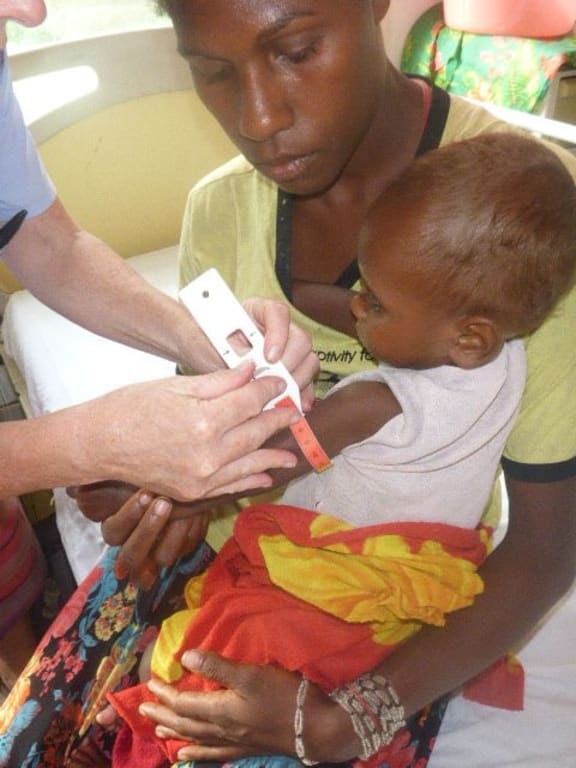Children are dying because of malnutrition in parts of Vanuatu more than a year after Cyclone Pam devastated crops and livelihoods across the Pacific island chain.
Malnutrition has long been a problem and with Cylcone Pam, which hit in March last year, followed by an El Nino drought, aid agencies say the problem has become worse.

A baby goes through a common manutrition screening at Lenakel Hospital. Photo: SUPPLIED
New Zealand doctor Leanne Cameron has been working in Lenakel Hospital on the island of Tanna for six months.
She has seen two children die in the past six weeks because malnutrition had made them too weak to fight illnesses.
Dr Cameron has been shocked at the level of the problem right on New Zealand's doorstep.
"They die from all those common childhood illnesses - the gastro-enteritis, the pneumonia. Things that in our country kids get better from"
Of the 150 children under five were admitted to Lenakel hospital in the past five months, 50 were classed as severely malnourished.
Many more were moderate cases.
Most were eating regularly but were not getting essential protein, Dr Cameron said.
"They eat plenty of kumara and potato and taro but that's all carbohydrate-rich food. If you don't get protein, you can't grow strong immune systems, you can't grow and develop."
Most people on the island lived a basic, subsistence lifestyle and with their crops wiped out had no money to buy protein like eggs, fish or meat, she said.
A nutritionist working for the World Health Organisation (WHO) and the health ministry, Louisa Tokon, said in one village people were so desperate after the cyclone they ate a wild plant that wasn't normally food.
"That really had no nutritional value but its something they resorted to because of their shortage of food supply."
At Lenakel hospital they give malnourished children a therapeutic food that looks and tastes like peanut butter to help them regain strength. Solving the wider problem is far more complicated.
Unicef's Pacific representative, Karen Allen, said the problem had been worse in the past 12 months in Vanuatu, but malnutrition had been in the Pacific for more than forty years.

New Zealand doctor, Leanne Cameron, at a village on Tanna where subsistence living is common. Photo: SUPPLIED
The problem was complicated and death rate hard to quantify because children tended to die from diseases exacerbated by malnutrition rather than from starvation.
And there was rarely one reason why a child was affected, she said.
"They perhaps haven't been breastfed, they've probably gotten diarrhoea, they've perhaps contracted a disease because they weren't immunised, they've perhaps had pneumonia. So, it comes from a complex set of problems that all have to be addressed together."
The ministry's nutritionist, Louisa Tokon says cyclone and El Nino have brought a new focus.
"We have expanded our network for screening and identification so we are finding them more and that is a good thing. We identify them and we reach them before it is too late."
Unicef is delivering high protein biscuits for the short term problem and running education programmes with the Ministry of Health for the long term ones.
They're teaching communities the importance of breastfeeding - which is great source of protein- and educating people about avoiding infection and about what the signs of malnutrition are, Dr Allen said.

